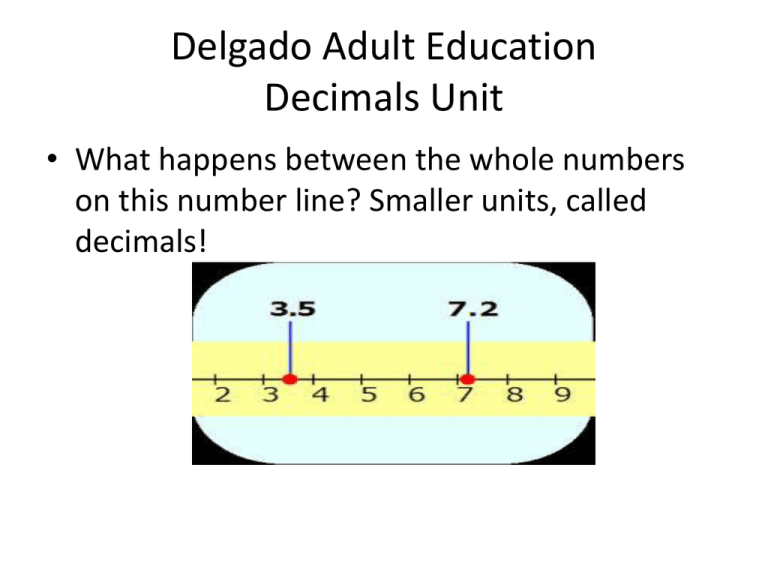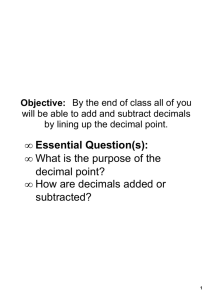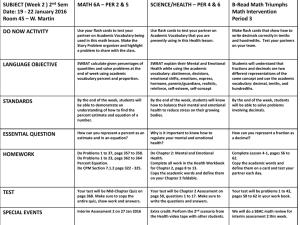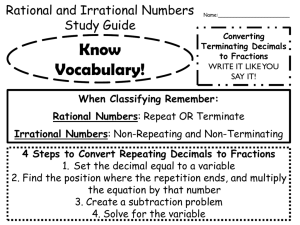File - Delgado Adult Ed, Patricia Eamon, Instructor
advertisement

Delgado Adult Education Decimals Unit • What happens between the whole numbers on this number line? Smaller units, called decimals! Decimals: what do they mean? • Like fractions and percents, decimals represent a part of a whole. • Think of it this way: in our money system, if we didn’t have coins, we would have to pay for everything in whole dollar amounts! • Money is a good example of decimals in action. • In our system, the penny is the smallest unit, and it represents 1/100 of a dollar. We write it as .01. • The nickel is the next largest unit, and it represents 5/100 of a dollar. We write it as .05. • The dime represents 10/100 (or 1/10) of a dollar, and is written as .10. • and the quarter represents 25/100 of a dollar, and is written as .25. Spend a moment looking at these diagrams of the value of each unit place on both sides of the decimal point. Make notes about any patterns you see. Place value in decimals • Our whole number system operates according to a system of 10’s, and so do our decimals. That is, when we move to the left, each unit is raised by a power of ten (x 10), and when we move to the right, each unit is reduced by a power of ten (÷ 10). Put plainly, numbers get bigger as we move to the left, and smaller as we move to the right. Notice that all the decimal place names end in –ths. They represent parts of a unit, or fractions. Place value exercises: • Write each of the numbers below, and circle the digit in the tenths place in each: 0.3 2.986 12.7 4.1509 428.63 • Write each of the numbers below, and circle the digit in the hundredths place in each: 0.27 0.018 4.26 3.8597 13.485 • Write the following as decimals: Four tenths, six and three tenths, nine thousandths, eight and twenty-nine ten-thousandths Answers • 3, 9, 7, 1, 6 • 7, 1, 6, 5, 8 • .4, 6.3, .009 (see how 0 is used as a placeholder here?), 8.0029 • If you got all these, great—move on to the next page! If you’d like a little more instruction and practice, click here (as with all Math is Fun pages, the exercises are at the bottom): • http://www.mathsisfun.com/decimals.html Adding and Subtracting Decimals • Adding and subtracting decimals is much like adding and subtracting whole numbers. • RULE: To add decimals, line up the decimal points with decimal point under decimal point. Remember that a whole number is understood to have a decimal point at the right (4 = 4.0). Example: 3.8 + 49 + .06 3.80 49.00 + .06 ___________ 52.86 You will find a list of videos on adding and subtracting decimals, along with some exercises, by clicking here: https://www.khanacademy.org/math/arithmetic/decimals/adding_dec imals/v/adding-decimals-example-1 Multiplying Decimals • • RULE: To multiply decimals, you do not have to line up the numbers by their decimal points. Put the number with more digits on the top, and multiply it as you would multiply whole numbers. When you have finished multiplying, count how many digits fall to the right of the decimal point in the numbers you multiplied, then make sure your answer has the same number of digits to the right of the decimal points. Example: Reviewing multiplication of whole numbers • Here are some links to videos and lessons on multiplying: • https://www.khanacademy.org/math/cc-fourth-grademath/cc-4th-mult-div-topic/cc-4thmultiplication/v/multiplying-2-digit-numbers • If you have not memorized the times tables up to 12 X 12, make this the session in which you do! You could raise your TABE score by multiple grades just by mastering multiplication. Please ask me for blank times tables and practice sheets. • http://www.mathsisfun.com/tables.html • http://www.mathsisfun.com/worksheets/multiplication.ph p Reviewing multiplication of decimals • Here are some links to videos and lessons on multiplying: • https://www.khanacademy.org/math/arithme tic/decimals/multiplying_decimals/v/intro-tomultiplying-decimals • http://www.mathsisfun.com/multiplyingdecimals.html Dividing decimals by whole numbers • RULE: To divide a decimal by a whole number, bring the decimal point up in the quotient (answer) directly above its position in the dividend (number being divided). Then, divide as you would with whole numbers. • https://www.khanacademy.org/math/cc-fifth-grade-math/cc5th-arith-operations/cc-5th-dividing-decimals/v/dividing-adecimal-by-a-whole-number Dividing decimals by decimals • RULE: To divide a decimal by a decimal, make the divisor a whole number. Move the decimal point in the divisor to the right as far as it will go. Also move the point in the dividend the same number of places that you moved the point in the divisor. Then divide. Videos and exercises on dividing decimals • https://www.khanacademy.org/math/cc-sixthgrade-math/cc-6th-arithmetic-operations/cc6th-div-decimals/v/dividing-decimals • http://www.mathsisfun.com/numbers/decima ls-dividing-animation.html • http://www.coolmath.com/prealgebra/02decimals/10-decimals-dividing-by-decimal01.htm Complete enough exercises to demonstrate to yourself that you have grasped the concept of decimals, and performing all the basic operations with them. • http://www.mathdrills.com/decimal/decimals_multiplication_0 302_whole_tenths_006.html • http://www.mathdrills.com/decimal/decimals_division_ones_te nths_006.html • http://www.mathdrills.com/decimal/decimals_division_ones_h undredths_all.html To reiterate a point made earlier… • If you find yourself adding 5 + 5 + 5 + 5 when you are asked to calculate the answer to 4 x 5, it is time for you to learn to multiply quickly and accurately. This will bring long multiplication, long division, and fractions, as well as all of the other math we’ll be doing all session, within your grasp. Honestly, you cannot pass the HiSET without first having fully grasped the fundamentals of arithmetic. Ask your instructor and study hall tutors for multiplication practice sheets! Congratulations on finishing this unit! You are now ready to take on the wonderful world of fractions.





